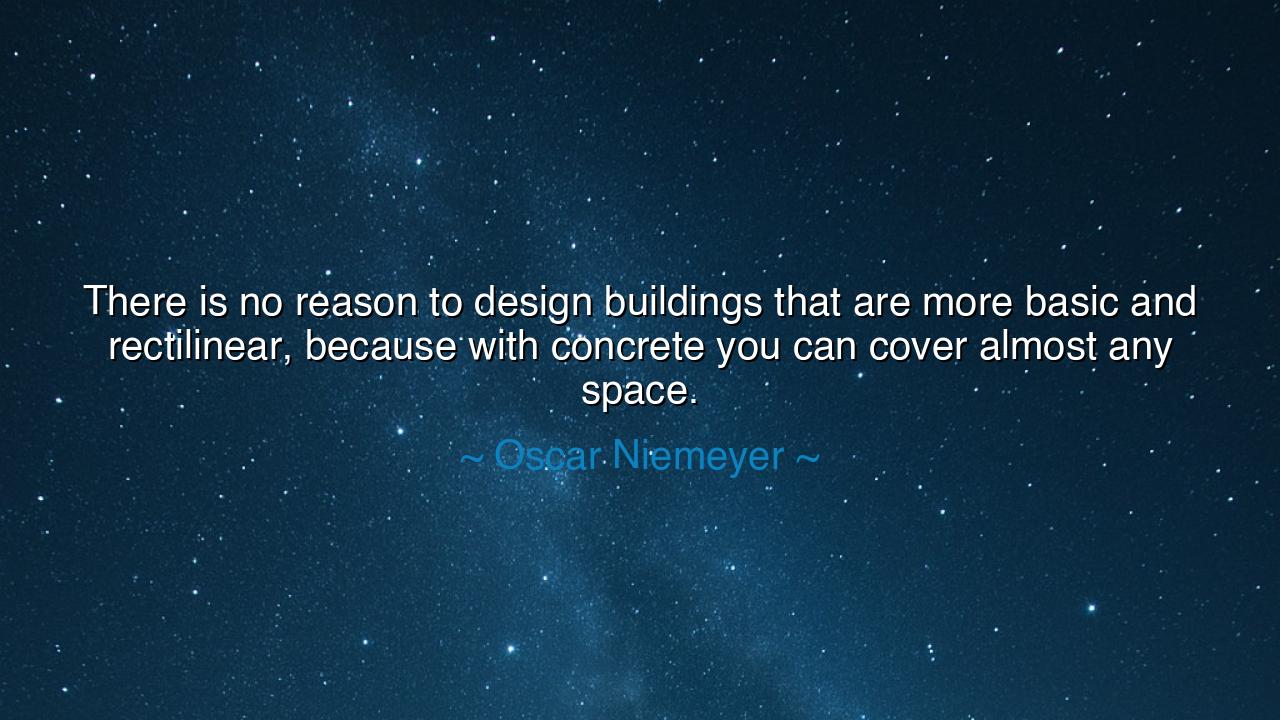
There is no reason to design buildings that are more basic and
There is no reason to design buildings that are more basic and rectilinear, because with concrete you can cover almost any space.






The words of Oscar Niemeyer—“There is no reason to design buildings that are more basic and rectilinear, because with concrete you can cover almost any space”—resound not merely as an architect’s technical observation, but as a philosophy of freedom, a declaration that art and imagination must not bow to convention. Within this statement lies the spirit of the creator who refuses limitation, who sees in the materials of his craft not barriers, but infinite possibility. Niemeyer, master of curve and form, speaks as one who gazed upon the cold rigidity of the modern world and dared to mold it into something alive, fluid, and human.
To understand his words, we must recall the age in which he built. The twentieth century, in its hunger for progress, birthed structures of glass and steel—functional, efficient, but often joyless. The straight line became a god; the square, a creed. Yet Niemeyer, working in his beloved Brazil, looked upon the horizon and saw something else. The mountains, the rivers, the body of a woman—none were rectilinear, yet all were beautiful. He beheld in concrete a new medium of expression, pliant as clay in the hands of a sculptor. For him, architecture was not geometry, but poetry written in space.
“With concrete, you can cover almost any space”—these words are a revelation. Concrete, humble in name and gray in hue, becomes under his vision a vessel for dreams. Where others saw heaviness, he saw flight; where others saw confinement, he saw liberation. Just as the painter finds infinity in color, Niemeyer found infinity in curve. He taught the world that beauty is not born of restriction, but of imagination unshackled—that form must follow not only function, but feeling.
In this belief, Niemeyer stands beside the ancient builders who refused to let their age define their art. Consider the architects of the Parthenon, who curved their columns subtly outward so that the human eye would see perfection in their imperfection. Or the engineers of the Roman aqueducts, who bent stone to the will of vision and need. Like them, Niemeyer understood that material is the servant of spirit, not its master. To build well, one must not ask, “What is possible?” but rather, “What can be imagined?”
He proved this faith through his works. In the city of Brasília, he shaped a capital unlike any other—a dream sculpted from concrete and sky. Its cathedrals rise like hands in prayer, its palaces float like clouds upon the earth. He showed the world that architecture could sing, that buildings could be sensual, graceful, alive. For him, every curve was a gesture of rebellion against monotony, a hymn to the freedom of the human spirit.
Yet beyond the realm of architecture, Niemeyer’s words whisper a greater wisdom: Do not live within straight lines. The rectilinear, in his metaphor, represents the ordinary—the safe, the predictable, the narrow. To live only in straight lines is to deny the divine complexity of life itself. The world is curved, time is curved, the path of the heart is never straight. Just as concrete can be molded into limitless forms, so too can the human will, if it dares to imagine beyond what seems rigid and fixed.
Let this be the teaching to those who create—whether in art, in work, or in life itself. Do not design your days to be basic and rectilinear. Seek the curve, the sweep of wonder, the gesture of boldness. Take what seems solid—your routine, your limitations, your fears—and shape them into something new. As Niemeyer saw infinite possibilities in concrete, so too can you see infinite possibilities in circumstance. For the tools of creation are not bound by material; they are bound only by the mind that wields them.
And thus, remember: there is no reason to build merely what is expected. Whether you build with stone or with dreams, let your work bear the mark of freedom. Let it curve toward beauty, let it rise with courage. For life itself is the greatest architecture, and it was never meant to be confined to straight lines.






AAdministratorAdministrator
Welcome, honored guests. Please leave a comment, we will respond soon